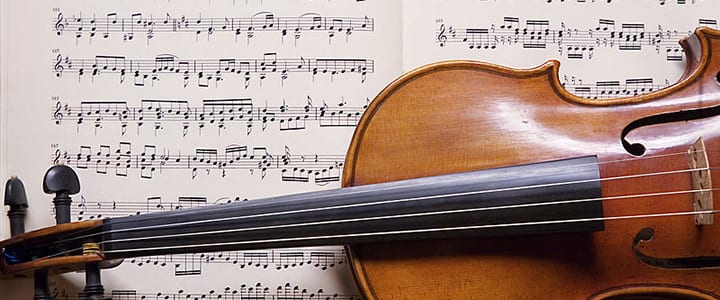How to Learn to Play the Violin: A Guide for Beginners

The violin is an instrument that has the capability to produce sound with a unique tone. After all, there’s a reason why it has been one of the most popular instruments throughout history.
Learning to play the violin can bring an immense amount of satisfaction, but not everybody knows how to do it. So, we’ve created a guide that has all the details you need to know about how to learn to play the violin.
Let’s take a look.
Set Aside Time Each Day
It shouldn’t come as a surprise that you will need to devote a certain amount of time each day in order to learn violin as efficiently as possible. The good news, though, is that this often can be accomplished in approximately 30 minutes per session.
Although you will technically make more progress by spending more time, not everybody has a schedule that can accommodate this.
The most important factor to remember, though, is consistency. It’s in your best interest to choose a block of time each day (or week if daily practices are overwhelming) in order to refine your skills. Before you know it, you’ll be impressed with how much progress you’ve made.
Listen to Violin Music on a Regular Basis
Many beginners tend to overlook the benefit that listening to violin music has. Over time, you’ll begin to recognize patterns and consistencies in the way the other violinists play.
Additionally, you’ll begin to develop an understanding of how you should play violin when accompanied by other instruments as opposed to playing it by itself.
Depending on your goals, you should listen to music that aligns with your ambitions. If you only want to play your violin in a solo setting, it’s in your best interest to prioritize listening to violin solos.
The more time you spend doing so, the more you’ll understand how your own music should sound.
If you find yourself becoming frustrated or disinterested, consider learning more about the history of the violin. You can read more here.
Practice Pieces Section by Section
It can be notably disheartening to consistently fail a certain violin piece. If you attempt to do a perfect run through each attempt, you may end up giving up before you ever finish.
Instead, it’s highly recommended that you practice pieces section by section. You can divide these segments however you would like, but it’s best to do so in order of difficulty.
The sections that are hardest for you should be kept as short as possible while still being cohesive. With enough time invested, you will find yourself able to seamlessly play an entire piece at once.
Watch Videos of Experienced Violinists
This is a piece of advice that cannot be underestimated.
By watching videos of experienced violinists perform, you can pick up on certain nuances that you may have not otherwise considered. This could be anything from how they hold their instrument to what position they keep their head at while they play.
Fortunately, the Internet allows you to find hundreds of thousands of clips in seconds. If you have a favorite violin piece, it’s best to start there and see where your journey takes you.
You can also watch multiple iterations of the same piece to determine consistencies between each player. From here, you can then try your best to emulate their styles.
Learn How to Read Sheet Music
Although it’s possible to perform violin pieces from memory, it’s highly recommended that you learn how to read sheet music.
Not only will this allow you to play newer pieces much more efficiently, but you will also develop a better understanding of how the music is composed. To elaborate, violinists who play by ear may not consider the structure of the piece that they’re playing — they’re simply playing it.
When you understand things like the arrangement, musical motifs, etc., it can be easier to understand how a song should be played. This will help you eliminate potential mistakes and improve the overall quality of your performance.
Consider Finding a Mentor or Teacher
If you have the opportunity to do so, it’s recommended that you look into finding a mentor or teacher. It’s also important to note the difference between a mentor and a teacher.
As the name suggests, a teacher will educate you on how to play this instrument in return for compensation. A mentor, however, may do so for free.
But, experienced violinists who are looking for mentees typically only choose those who are highly dedicated to the craft. This means that you may need to allocate more time per week than you anticipated.
Additionally, your mentor may want to teach you other skills, such as composing.
If you have the free time and are open to learning, working with a mentor can be an invaluable experience that you may not find in the future. Regardless of which path you take, both individuals can drastically improve the rate at which you learn.
So, keep this in mind when making your decision.
Understanding How to Learn to Play the Violin Can Be Difficult
But, all of your hard work will pay off. With the above information in mind, you’ll be able to ensure that you get yourself on the right track toward how to learn to play the violin.
Want to learn more info you should keep in mind? Be sure to explore what the rest of our blog has to offer.
Recent Posts
 What are Some Common Mistakes to Avoid While Trimming Your Beard?
What are Some Common Mistakes to Avoid While Trimming Your Beard? A Guide to Updating Your Skincare Routine for Summer
A Guide to Updating Your Skincare Routine for Summer 5 Things To Keep In Mind When Ordering From A China Hair Factory
5 Things To Keep In Mind When Ordering From A China Hair Factory Why Moisturising Your Hands Is So Important?
Why Moisturising Your Hands Is So Important? What Is Your Curl Pattern Type, And How Do You Deal With It?
What Is Your Curl Pattern Type, And How Do You Deal With It? Dermal Fillers: What Are Dermal Fillers, How Are They Used, And Who Uses Them?
Dermal Fillers: What Are Dermal Fillers, How Are They Used, And Who Uses Them? How Filorga Optim Eyes Works
How Filorga Optim Eyes Works Reverse Balayage: A Low Maintenance Cost For Beauty in Winter
Reverse Balayage: A Low Maintenance Cost For Beauty in Winter Shape the Brows with efficient Eyebrows Tinting
Shape the Brows with efficient Eyebrows Tinting Different Types of Hair Extensions
Different Types of Hair Extensions
